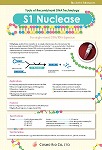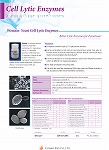Antibacterial effects of Labiase
(1) Bacteriolytic Spectrum of Labiase
The bacteriolytic spectrum of labiase was examined by measuring the bacteriolytic activity against bacterial strains. Turbidity reduction rates in bacterial suspensions were determined as the bacteriolytic activities of labiase. Bacterial suspensions in a logarithmic growth phase were prepared with McIlvaine buffer (pH 4.0) at turbidity of 1.0 (OD660) and at a final labiase concentration of 0.25% to measure turbidity after 2-hour reaction. The turbidity of a bacterial suspension prepared in the same manner without labiase was also measured as a control. Dissolution rates were determined using the formula below. Results are shown in Table 1.
[Formula]
(d0-dt)-(D0-Dt)
Dissolution rate (%) = ------------------- ×100
d0
d(0,t): Turbidity of reaction solution at 0 and t hours
D(0,t): Turbidity of the control at 0 and t hours
As shown in Table 1, labiase efficiently lysed gram-negative bacteria (e.g., Escherichia coli and Pseudomonas spp.), as well as gram-positive bacteria (e.g., lactic acid and hiochi bacteria), suggesting a broad bacteriolytic spectrum. Of note, it lysed hiochi bacteria (i.e., causative bacteria of sake spoilage), Staphylococcus aureus IFO12732 (i.e., causative bacteria of food poisoning), and Streptococcus mutans JCM5705 (i.e., causative bacteria of dental caries), suggesting the possible applications of labiase to the prevention of hiochi, food poisoning, and dental caries.
(2) Bacteriolytic activity of Labiase in the presence of alcohol
To examine the bacteriolytic activities of labiase in the presence of alcohol, the dissolution rates of lactic acid and hiochi bacteria were compared in the same reaction system as that in Test (1) with or without 15% ethanol. Results are shown in Table 2.
As shown in Table 2, the bacteriolytic activities of labiase were comparable in cases with or without 15% ethanol. Specifically, the bacteriolytic activities of labiase were sufficiently high even when labiase was directly contacted with alcoholic beverages (e.g., sake and beer) of an alcohol concentration of 15%.
(3) Growth inhibition test of Staphylococcus aureus using Labiase (S. aureus IFO12732)
A filter-sterilized aqueous solution of labiase (or sterilized distilled water as a control) was added at a final concentration of 0.25% to an autoclaved general bacterial medium, Brain Heart Infusion Broth "Nissui" (Nissui Pharmaceutical Co., Ltd.). These media were inoculated with a loopful of Staphylococcus aureus (IFO12732), a causative bacterium of food poisoning, using a platinum loop, followed by shaking culture at 37oC for 24 hours to compare the time course of turbidity (OD660). As a control, egg white lysozyme (Sigma) was added at a final concentration of 0.25%. Results are shown in Figure 1.
For example, if there had been bacteriostatic effects until absorbance changed, the effects were noted for about 2 and 6 hours with egg white lysozyme and labiase added at 0.25% to the medium, respectively, as compared with an additive-free medium (Figure 1). Thus, the growth of causative bacteria of food poisoning can be suppressed by adding labiase to food. The effects of labiase were more potent than those of egg-white lysozyme used as a preservative.
(4) Growth inhibition test of hiochi bacteria using labiase
A filter-sterilized aqueous solution of labiase (or sterilized distilled water as a control) was added at a final concentration of 0.25, 0.125, or 0.025% to an autoclaved SI medium (1% yeast extract, 0.5% polypeptone, 2.5% glucose, 1% sodium acetate, 0.01% magnesium sulfate, 0.00025% manganese sulfate, 0.00025% ferrous sulfate, 0.005% mevalonic acid, and 10% ethanol, pH5.1). These media were inoculated with a loopful of hiochi bacteria (S24) using a platinum loop, followed by static culture at 30oC for 120 hours to compare the time course of turbidity (OD660). As a control, egg white lysozyme (Sigma) was added at a final concentration of 0.25%. Results are shown in Figure 2.
As shown in Figure 2, no growth of hiochi bacteria S24 was observed in labiase-added medium as compared with additive-free medium, demonstrating the marked growth inhibitory effects of labiase on hiochi bacteria. On the other hand, little growth inhibitory effect on hiochi bacteria was observed for egg white lysozyme. A similar test was conducted with other hiochi bacterial strains. Then, similar results were obtained for all the strains. The present study was conducted in the presence of 10% ethanol, demonstrating the growth inhibitory effects of labiase even in the presence of at least 10% ethanol. Thus, labiase can prevent the contamination of alcoholic beverages (e.g., sake and beer) with hiochi and lactic acid bacteria.
(5) Growth inhibition test of S. mutans JCM5705 using Labiase
A filter-sterilized aqueous solution of labiase (or sterilized distilled water as a control) was added at a final concentration of 0.25, 0.125, or 0.25% to an autoclaved general bacterial medium, Brain Heart Infusion Broth "Nissui" (Nissui Pharmaceutical Co., Ltd.). These media were inoculated with a loopful of S. mutans JCM5705, a causative bacterium of dental caries, using a platinum loop, followed by static culture at 37oC for 24 hours to compare the time course of turbidity (OD660). As a control, egg white lysozyme (Sigma) was added at a final concentration of 0.25%. Results are shown in Figure 3.
As shown in Figure 3, no growth of S. mutans JCM5705 was observed in labiase-added medium as compared with additive-free medium, demonstrating the marked growth inhibitory effects of labiase on S. mutans. On the other hand, no growth inhibitory effect on S. mutans was observed for egg white lysozyme. Thus, labiase can suppress the growth of S. mutans, a causative bacterium of dental caries, and can be used as an anticaries agent when mixed in toothpaste, powdered dentifrice, or mouthwash.
(6) Heat susceptibility of Labiase
Using the same method as in Tests (3), (4), and (5), the growth inhibitory effects of labiase on bacteria were examined with or without heat treatment in boiling water for 15 minutes before the addition of labiase into medium at a final concentration of 0.25%. Results are shown in Figures 4, 5, and 6. The present study was conducted to examine whether the growth inhibitory effects were definitely caused by the bacteriolytic activity of labiase or the activities of other bacterial components, by heat-inactivating the bacteriolytic activity of labiase (verified). (284 characters
As shown in Figure 4, the growth inhibitory effects on Staphylococcus aureus remained for about 3 hours even after enzyme inactivation by heat treatment, demonstrating the effects of growth inhibitory compounds, besides the bacteriolytic activity of labiase.
As shown in Figure 5, the growth of hiochi bacteria (S24) was completely inhibited for at least 120 hours with or without heat treatment, demonstrating effects, besides the bacteriolytic activity of labiase.
As shown in Figure 6, the growth of S. mutans was incompletely inhibited by heating, suggesting the effects of unknown growth inhibitory compounds, besides the bacteriolytic activity of labiase. In conclusion, the growth inhibitory effects of labiase were the combination of the effects of unknown compounds in labiase and the bacteriolytic activity of cell wall lytic enzyme, although the inhibitory effects slightly varied with strains. This could be easily predicted from the facts that S. fulvissimus, a labiase-producing bacterium, belongs to actinomycetes and, therefore, is likely to produce an antibacterial substance and that the enzyme is a crude enzyme preparation. The antibacterial effects of labiase were highly heat-resistant.


